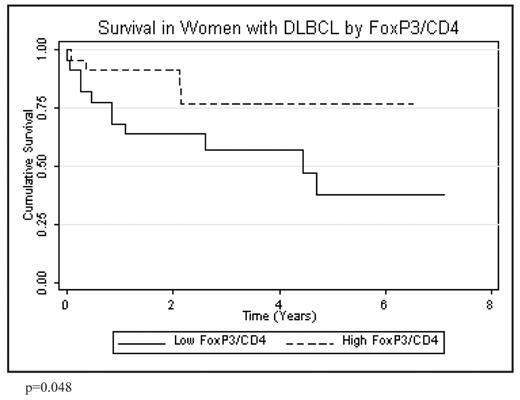Abstract
Introduction: Among patients with diffuse large B-cell lymphoma (DLBCL), it is well documented that for unknown reasons men have shorter progression-free and overall survival than women. Recently, a specialized subset of CD4+ T-cells, called regulatory T-cells (T-regs), which can suppress the effector functions of cytotoxic CD8+ T-cells, has been proposed to have a role in controlling tumor progression. While elevated T-regs in animal models of cancer can block anti-tumor responses and thereby enhance tumor growth, paradoxically, high T-regs are associated with improved survival in humans with DLBCL. To our knowledge, the relationship between T-regs and gender has not been investigated. Since T-regs constitutively express FoxP3, a transcription factor of the forkhead family, we used this marker to retrospectively study the number and density of FoxP3+ T-regs in tissue sections from both male and female patients with DLBCL, and to compare their effects on survival.
Methods: Tumor microarrays of DLBCL containing three 1 mm diameter cores per patient were immunohistochemically stained for FoxP3 and CD4. We enumerated tumor infiltrating FoxP3+ lymphocytes by counting positive nuclei that crossed the lines of a 1 mm2 10×10 grid in a 10× ocular that was combined with a 40× objective in a BX41 Olympus microscope. The mean FoxP3 T-regs per field and the ratio of FoxP3 T-regs to total CD4+ T-cells were compared between 34 men and 48 women with de novo, non-AIDS related DLBCL. The median values were used as cut-offs for total FoxP3 counts and for FoxP3/CD4 ratios. We analyzed survival differences between “high” and “low” groups by using Kaplan-Meier curves and Logrank tests. Cox regression analyses were used to compare mortality after adjusting for age and staging.
Results: Men had lower values than women both for mean total FoxP3 counts (7.05 vs 8.15, p=0.636) and for mean FoxP3/CD4 ratios (0.31 vs 0.51, p=0.183). Differences between genders in the proportion above the overall median (“high” group) were statistically significant when comparing total FoxP3 counts (32.4% in men vs. 60.4% in women, p=0.012) and FoxP3/CD4 ratios (35.3% vs. 58.3%, p=0.040). Using gender-specific cut-offs, higher FoxP3/CD4 ratios were associated with worse overall survival in men (Figure 1, p=0.052), but improved overall survival in women (Figure 2, p=0.047). The crude hazard ratio comparing groups with gender-specific “high” vs. “low” FoxP3/CD4 ratios was 3.99 (p=0.077) in men and 0.33 (p=0.061) in women. Adjusting for age did not result in significant changes, but adjusting for stage at diagnosis shifted the hazard ratios toward the null (1.06, p=0.947 in men and 0.45, p=0.218 in women). In men, those in the “high” FOXP3/CD4 ratio group appeared more likely to have stage 3 or 4 disease at diagnosis compared to the “low” group (66.7% vs 36.8%, p=0.139). This was not seen in women (33.3% vs 38.9%, p=0.718).
Conclusions: More T-regs infiltrated DLBCL in women than in men. This is difficult to explain, but could be a clue to the relationship between survival and gender in DLBCL. Paradoxically, high T-regs predicted worse overall survival in men, but better overall survival in women. Also, stage 3 or 4 disease at diagnosis was associated with high T-regs in men but not in women. To confirm the significance of these findings, a larger sample size and prospective study design will be needed.
Disclosures: No relevant conflicts of interest to declare.
Author notes
Corresponding author



This feature is available to Subscribers Only
Sign In or Create an Account Close Modal